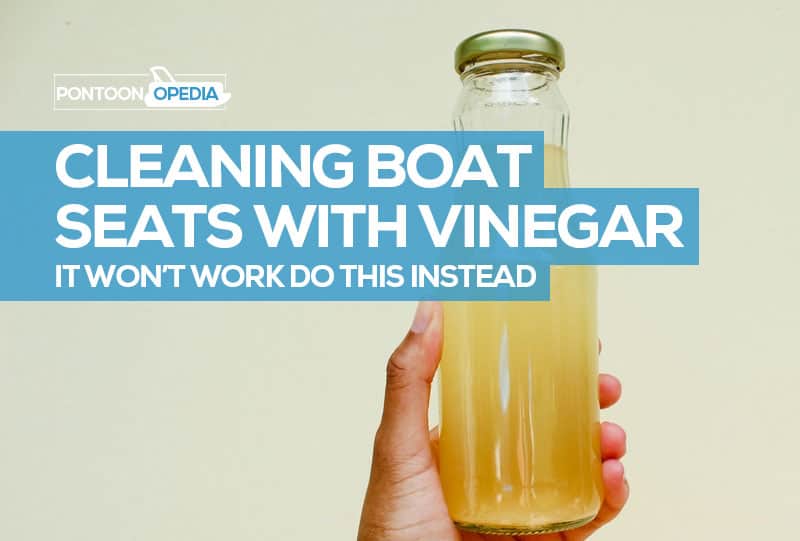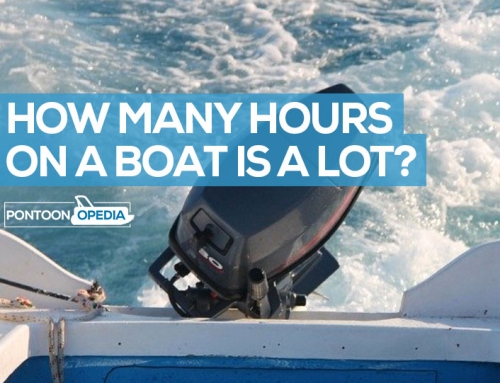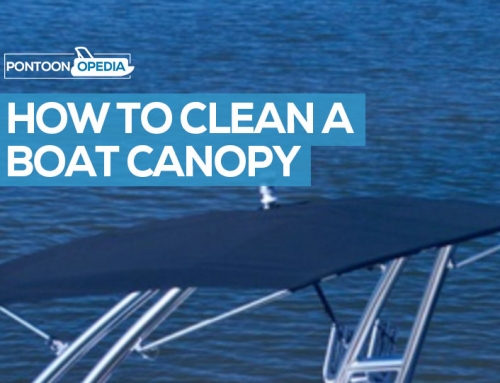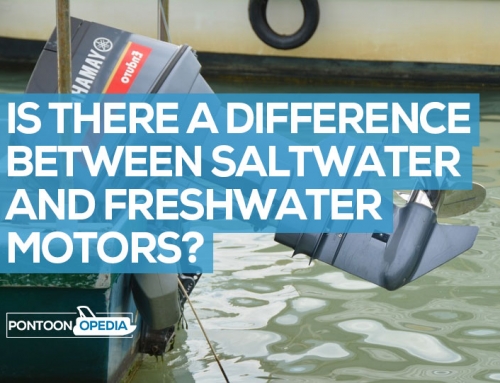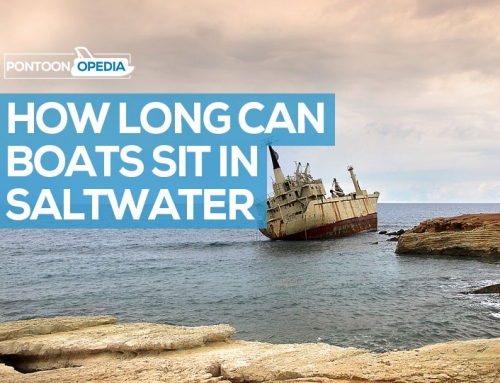The boating community is full of useful comments on how you can best clean up vinyl boat seats, with one suggestion I commonly see being to clean boat seats with vinegar. But does it work and it there a better way to get rid of mold and mildew or water spots?
As part of my research, I stumbled across an article on the Boating Mag website where they performed an experiment to see if cleaning boat seats with vinegar worked when compared to 2 other methods; bleach or using an off the shelf cleaning product.
Below you can see a photo showing the comparison of how vinyl boats seats come up when cleaned with vinegar versus bleach or a bottle of specialist cleaning fluid.

Image copyright: Lenny Rudow – https://www.boatingmag.com/cleaning-mildewed-boat-seats-and-vinyl
In this test they used a product called Iosso mold and mildew stain remover on the right-hand seat cushion. As you can see, it’s a much better result that the vinegar and water solution in the middle cushion, but not really a vast improvement on using bleach on the left-hand cushion.
This was a great experiment to see if a water and vinegar worked for cleaning vinyl boat seats, but the results are really disappointing to say the least. Plus, with vinegar being an acid it could end up eating away at the stitching, leading to even worse problems over time.
Want even better results?
Which brings me onto another experiment I found on a Facebook group where instead a boat owner used a different cleaning product altogether to clean up his vinyl boats seats. You can see the results of that test below.
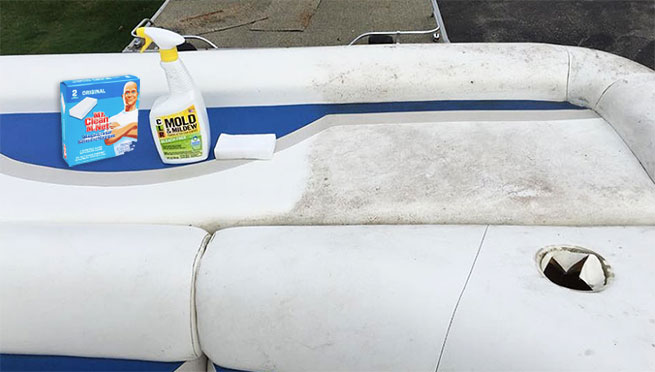
The results from using Magic Eraser and CLR cleaning spray over vinegar.
In the photo above he used a product called CLR Mold and Mildew remover with Mr Clean Magic Eraser. The results were so much better. Just compare the image above to the comparison test that was published on the Boat Mag photo towards the top of this page.
What cleaning products you need to get results like the photo
This is how he did it, with links to the various cleaning products and methods he used:
- Spray CLR Mold Remover onto the seats (buy on Amazon)
- Use a soft brush and scrub lightly
- Wipe away mildew debris with a microfiber cloth (buy on Amazon)
- Use a Magic Eraser for the really stubborn stains (buy on Amazon)
- Seal and protect the vinyl with a 303 protectant (buy on Amazon)
Here’s those steps in short format below.
5 steps to get a clean finish without using vinegar
#1: Spray CLR Mold Remover and leave for 5 to 10 minutes
Spray over your vinyl boat seats, making sure not to miss getting the solution down into the seams and gaps between the seating. It doesn’t have any bleach in the ingredients, so won’t damage threads like bleach and vinegar can.
Leave it to soak and settle for 5 to 10 minutes, or with really nasty marks and stains perhaps a little bit longer.
#2: Scrub very lightly with a soft brush
After 5 to 10 minutes, take a non-abrasive soft brush and start to scrub lightly in circular motions over the stains and marks on the seating.
This should remove the majority of stains, mildew, mold, and water spots and will clean much better than a vinegar and water solution or any harsh bleach-based product.
#3: Wipe the dirt away with a microfiber cloth
What you will probably now see is that the mess has mostly come up and away from the vinyl, but it might have smeared across the seating.
Take a microfiber cloth, and using circular movements again, using your fingers to push the cloth into the gaps, seams and stiches.
This will have cleaned up of the bulk of the dirt and scum, but chances are you will still need to move onto step 4 to get the best result possible when seeking the best alternative to cleaning vinyl boat seats with vinegar.
#4: Clean away the stubborn mildew with Mr Clean Magic Eraser
If you’re boat has been neglected for a while, and we can all be guilty of that, you’re going to need some extra ammunition to clean mildew and mold.
Mr Clean Magic Eraser is like taking a Monster Truck to jammed highway. It will obliterate any marks left.
Handy Hint: Mr. Clean Magic Eraser can be abrasive if you work it too hard. Don’t press down too harshly as you might scratch the vinyl. Just use light pressure smooth cleaning movements and it will work just fine.
Use soft motions, don’t go too hard onto the vinyl. All you need are some soft rubs and any leftover stains should come up a treat.
It’s amazing and is trusted by boat owners all across the world to do the job.
#5: 303 protectant seals and protects the vinyl
And lastly, we want to make sure that you not only get a decent finish, but also protect your seating for the next season.
A marine-grade 303 protectant can be applied to your vinyl seats to not just help prevent mildew in the future, but also protect against UV damage such as cracking, discoloring, and fading.
Buy the 303 protectant I recommend in this process by clicking on the image you see of the product. This will take you over to Amazon where you can buy it. It comes with full instructions on how to use it.
Handy Hint: You can read the full cleaning process outlined above with more detailed steps in this guide to cleaning mildew off boat seats. It works really well and gives you far better results than if you were cleaning your boat seats with vinegar and water.
Don’t use bleach to clean your boat seats
Tempting as it might be to save money (not that the products above cost a lot to buy) and use household cleaning items like bleach and vinegar, please don’t do it!
Bleach is a very harsh chemical and over time will harm the seating fabric. The most commonly reported damage will initially be to the seams and stitching. When exposed to bleach the threads will start to come apart.
The vinyl boat seat manufacturers also advise against a bleach solution, as it can also damage the vinyl over time.
In fact, in the test on the Boating Mag website they even went to so far to say:
“Surface stains were eradicated with a healthy dose of bleach. A year later, the vinyl itself feels significantly less supple, there is visible deterioration in the stitching, and worst of all, the mildew returned with a vengeance.”
Cleaning vinyl boat seats with bleach is not advisable. Don’t do it if you value your boat.
Why you should keep your boat seats clean and protected
Nothing says “I don’t care” more than mildew stains and marks on your vinyl seats and cushions. Not only do the black streaks and spots look ugly (who is going to want to sit on that?) but can also depreciate your boat’s value if you want to sell it on – and it will mean you won’t have reupholster them at any point in the future.
In fact, I had to replace my captain’s chair for this very reason, as it was beyond cleaning. You can read which pontoon boat captain’s chairs I have reviewed and rated elsewhere on Pontoonopedia.
In a press release from 2018, the president of a marine canvas and upholstery company based in Miami, said:
“Mildew is a fungus. You can clean it off the vinyl’s surface and kill the spores with disinfectant, but unless you replace the seat’s foam as well as the vinyl covering, it will come back. You’ll get one season, maybe two, depending on humidity and temperature, but just cleaning the stains off won’t end your mildew problems.”
That’s why it’s important to use a marine-grade 303 protectant as described in step 5 of the cleaning process outlined above.
The alternative is to buy new seats and cushions, but these will cost a lot more money from your local dealer, manufacturer, or have custom made by an upholstery store.
If you are considering buying new boat seats and haven’t been able to clean them up with vinegar or any of the products recommended here (it could have gone beyond the point of no return) then here are some tips on what to ask for:
- Demand replacement boat vinyl that uses an anti-fungal treatment.
- Demand that the seats are made from heavy-duty vinyl with a minimum rating of 28 ounces.
- Demand that they meet the American Society for Testing and Materials G21 standards.
What other boaters say
I also put the word out in some private pontoon boat Facebook groups to see how people have fared themselves when cleaning their boat seats with vinegar. Here is a selection of some of the top liked comments:
“Vinegar and water didn’t help with a lot of the mildew and mold spots on my vinyl seats last year. This year I switched to Magic Eraser and the CLR stuff, using 303 protectants to use after cleaning. I let is set a bit, but not too dry, and stubborn spots may take a second round of light scrubbing.”
“I use some cheap general mold and mildew remover that comes in a bottle spray, then let it sit on the vinyl for 10 minutes before spraying off. I would never use bleach. The spray mildew remover won’t destroy seat threads and best of all it works.”
“I work for a boat dealer, and whilst we don’t specify vinegar use on seating, we do use it quite a bit for cleaning any hard-durable finish on our boats. It will remove water spotting very well, but for vinyl seats you need something a bit more specialist and made for purpose.”
“My wife prefers to use natural cleaners including vinegar, it works great but only really for water spotting, not the seats so well. I hate the smell of vinegar though, so always insist on a proper boat cleaning product with no harsh chemical smells.”
“I also use vinegar for cleaning up water spots but find it won’t work great with mold which is where the Mr Clean Magic Erasers come into their own.”
“Today I cleaned the boat finally. The seats look brand new and I used Simple Green to clean the dirt off first, then used a wet Mr. Clean Magic Eraser which works amazing well to get the tough dirt out. Finished it all off with 303 Aerospace UV protectant to seal the seats.”
“We didn’t take before and after pictures, but we had mildew on our seats and used Mr. Clean magic eraser which made them look new again! We were afraid of using any cleaners and damaging the threads. It’s 100% recommended!”
How to avoid mildew and mold in the first place
Whilst marine vinyl seating has been designed to resist mold and mildew, we all know that this never the case. When you throw in the accumulated effects of dirt, water, and sunscreen, it doesn’t take long for mold do develop.
Moisture from the air, water from the lake or sea, and sweat from bodies provides an ideal environment for mildew to develop.
If there’s water, there will be mold – and no amount of vinegar is going to shift it.
But there are a few steps you can take to stop it developing in the first place:
- Towel down all boat seats after each and every trip.
- Then use a mildew preventer spray.
- You can also reduce the humidity in your boat and ensure good ventilation when covered.
The last word…
I hope that you find this guide to cleaning boat seats helpful, and you aren’t tempted to use vinegar or bleach next time.
I’ve also published additional guides on Pontoonopedia to cleaning and taking care of your boat, which I’ve listed below. Go take a look!
- How to get black stains out of boat carpet
- How to clean algae off pontoon tubes
- Find out which inflatable boat cleaner I recommend and why
- How vinegar can work really well on aluminum boats
And lastly, recently I had to replace the old vacuum cleaner we had on our boat as it finally decided to pack up.
I got the views of other boat owners I know and researched loads online until I came up with what I believe to be the best vacuum cleaner for a boat. To see why I chose this one and the results you can get read my boat vacuum cleaner investigation results.

